(The opinions and views expressed in the commentaries and letters to the Editor of The Somerville Times belong solely to the authors and do not reflect the views or opinions of The Somerville Times, its staff or publishers.)
 By William C. Shelton
By William C. Shelton
Somerville is in the midst of a deepening crisis. The Mayor and others have named it a “housing crisis.” But the crisis is systemic, and our shrinking stock of affordable housing is only one aspect.
Somerville as a system
For most of us, systems thinking does not come easily. We are schooled in classes that separate the world into different subjects, and we work in organizations and polities that compartmentalize it into separate functions and jurisdictions.
So we make plans that do not capture how our city—or organization, or planet—is composed of many interacting elements that influence and transform each other over time, forming a whole qualitatively different from the sum of those parts.
As I write this, two Somerville groups are making such plans. The City Council is conducting its budget review, which is the quantification of an annual plan. The intrinsic nature of their one-year horizon, limited scope of information, and episodic and discontinuous decision making necessarily constrain their ability to plan systemically, as many Councilors would wish to do.
Separately, a committee of which I am a member is working to update SomerVision 2030, the city’s comprehensive plan. Adopted only seven years ago, it determined that planning decisions would be guided by many worthy principles, and by separate numerical objectives for new jobs, housing units, open-space acreage, and trips by modes other than cars.
Simplifying planning considerations to these numbers and principles afforded a certain degree of elegance. But SomerVision 2030 did not go very far in understanding how these separate objectives connect—supporting, constraining, and transforming each other as part of a larger system. Or, that that system extends beyond the city.
And SomerVision 2040 committee members are still obligated to plan their respective subject areas separately, although we are promised that there will be one or more “reconciliation sessions.”
I want to make the systemic connections that public planning processes in Somerville have not thus far made. Many newcomers to the city who displaced long-term residents over the last ten or more years by bidding up housing prices are now frightened that they will be similarly displaced. Accordingly, affordable housing has become Somerville’s hottest policy issue. So I will attempt to use it as a narrative thread around which to weave other systemic local and regional forces.
Affordable housing
Few, if any other, Massachusetts cities have stretched more to preserve some measure of affordable housing. We have instituted transfer fee legislation, a Community Preservation Act, 100-Homes Program, Condominium Conversion Ordinance, Affordable Housing Trust Fund, Office of Housing Sustainability, Community Land Trust, the highest inclusionary zoning requirements, and numerous other housing programs.
Yet Boston has, proportionately, twice as much housing that is affordable permanently, or for at least 30 years. Cambridge has half again as much.
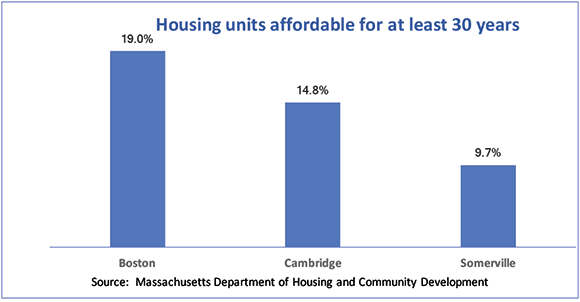
Fiscal Health
The most important reason for these differences is simply that those cities have more money. Even though Boston’s median household income is only two-thirds Somerville’s, Boston spends 39% more per resident. Cambridge spends 48% more, while its residential property tax rate is only 55% that of Somerville’s At the same time, residential properties produce twice the municipal costs that commercial properties produce.
One measure of a city’s fiscal strength is its free cash. Boston has almost three times Somerville’s free cash per resident; Cambridge, twelve times.
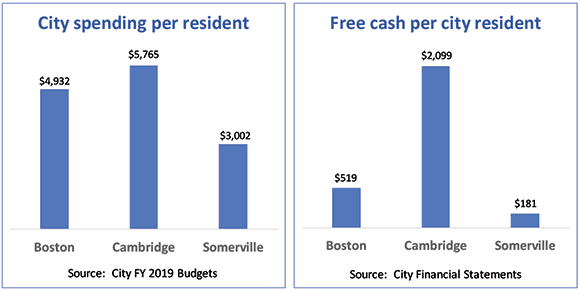
Commercial development
Boston and Cambridge have more money because they have more commercial property. Only 17% of Somerville’s real estate tax base is commercial. It generates 24% of the City’s real estate tax revenue because the commercial tax rate is 38% higher than the residential rate.
Because Boston’s and Cambridge’s residential-to-commercial property ratio is more balanced, their commercial real estate tax revenues per resident are 4 and 4.7 times that of Somerville’s.
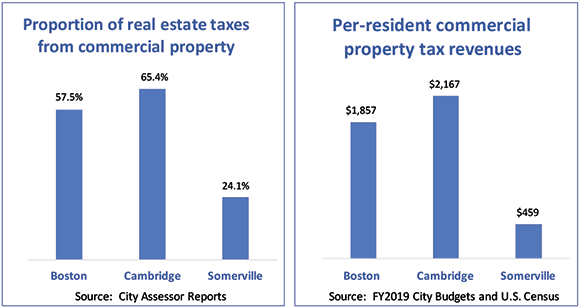
Jobs vs. workers
So the ratio between Somerville residents and jobs is also extremely unbalanced. Boston and Cambridge employ our residents. Only 15% of Somerville residents with jobs work in Somerville; more than half work in Boston and Cambridge.
As municipalities, Boston and Cambridge make money on the commercial properties in which Somerville residents work, while we house their workers and lose money on the residential properties in which they live.
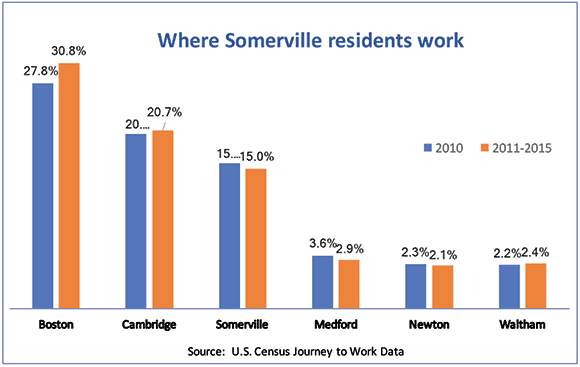
Land uses
The figures shown in the net-municipal-income-by-land-use graph represent tax revenue generated by different property types, minus the cost of providing city services to them. But they are not quite accurate.
When Carson Bise performed this analysis, he was told to assume that the city would not build any more municipal buildings. So costs of the planned Public Safety building were excluded, as was debt service on the new high school, that was also excluded from the Proposition 2½ limit. Costs of new water and sewer infrastructure were underestimated.
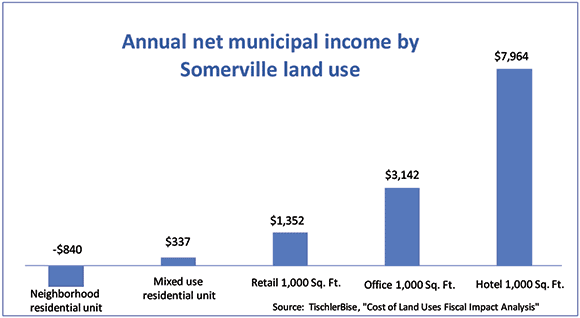
Therefore, net-income amounts for each of the graph’s land uses are, in reality, lower. Few residential properties break even, and most produce deep losses.
“Mixed-Use Residential” housing is the units in Assembly Square and that are planned for Union Square. The difference between them and most Somerville housing is that the “Neighborhood Residential” category assumes one school-age child per dwelling unit, and Mixed-Use Residential assumes one child per twelve units. So to break even, or produce only small losses, housing has to exclude families.
Lab space, which did not appear in the analysis, would conservatively generate $5,000 per year per 1,000 square feet because lab equipment is taxable. Hotel net income is high because revenues include substantial excise taxes. But hotel occupancy can be volatile.
Jobs and wages
Somerville’s severe scarcity of commercial property produces a severe imbalance between jobs and workers, and between work sectors. Average weekly wages here reflect this imbalance. In Somerville, they are $472 and $1,081 less than in Boston and Cambridge, respectively.
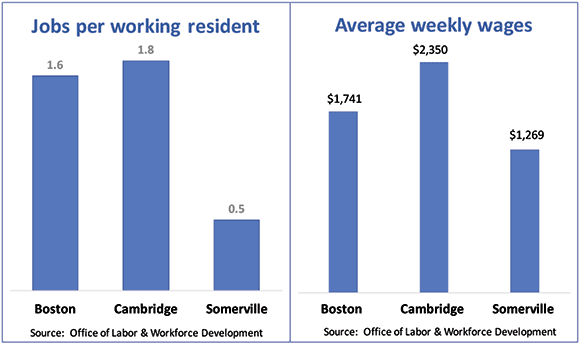
That’s because jobs in Somerville are concentrated in lower-wage sectors and underrepresented in higher-wage sectors. And that’s because we lack properties in which to house higher-wage sectors. The industrial sectors in the “Percentage of total jobs” graph are arrayed from lowest-wage to highest, left to right.
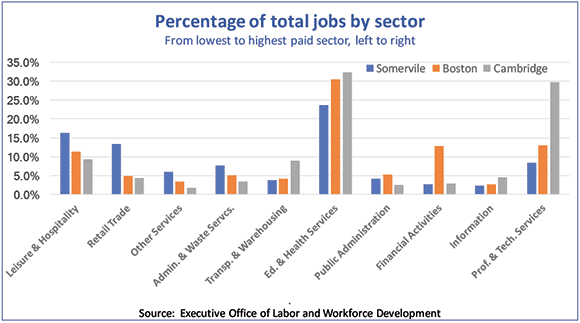
Open space
Pursuit of SomerVision’s housing-units objective, in turn, systemically affects the open-space objective. The more new housing that we build, the greater is our need for green space, and the more we absorb land that could be used for it—or for income-generating commercial properties—while we further erode our capacity to pay for green space.
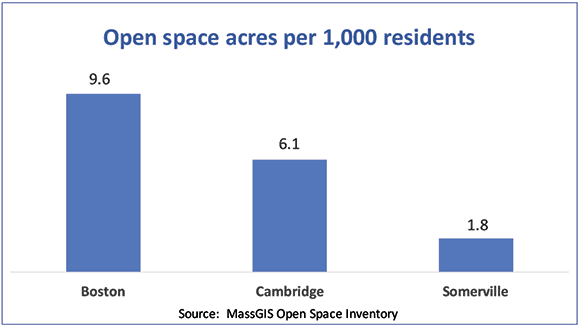
In the last two decades there has been an explosion in clinical research demonstrating the breathtaking impacts of the presence and absence of green space on human mental and physical health. Somerville has the worst proportion of usable open space per resident in the Commonwealth. Low-income households suffer most from this deficit because they don’t have the means to visit greener settings.
Already the densest city in New England, Somerville continues to sacrifice the wellbeing of its citizens, while other cities do not.
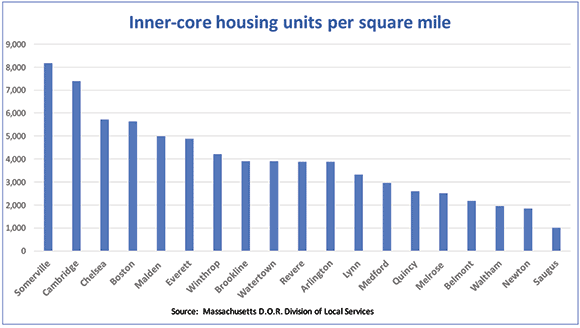
Trips, traffic and congestion
We are performing well on the SomerVision 2030 objective of shifting new trips onto transit, bike, and walking modes. Yet vehicles registered here, and traffic and parking congestion, continue to increase. This is because we keep building more unaffordable housing, and because more affluent people with cars displace lower-income people without cars in existing housing.
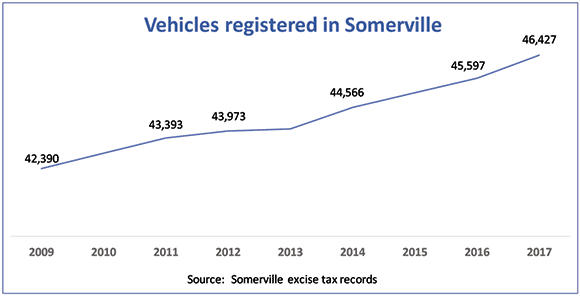
Community fabric
Somerville was once renowned for its tight community fabric. But the long-term residents who have been priced out were disproportionately those who coached little league, looked in on elderly neighbors, participated in voluntary associations, and wove the community fabric. In their absence, the fabric has unraveled.
It’s hard to find quantitative measures for community. But we know that relationship density, participation in voluntary associations, civic engagement, and other measures of social capital are strongly correlated with the presence of families. They are becoming ever scarcer in our city as they are priced out by more affluent, childless transients. And developers are building few units that can accommodate families. So our age distribution is acutely out of balance as well.
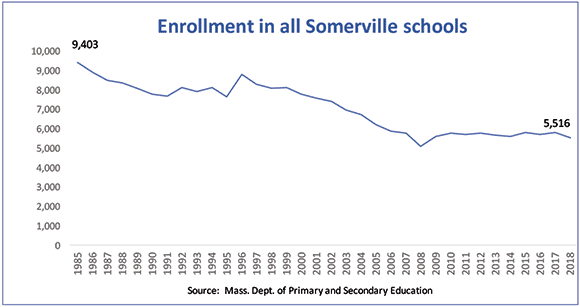
Affordable housing consequences
If we examine Somerville as part of a system, we discover that the greatest obstacle to housing affordability is insufficient commercial development. The scarcity of living-wage jobs prevents low- and moderate-income people from paying for market-rate housing, while our residential-dominant tax base produces insufficient income to fully fund permanently affordable housing efforts.
Meanwhile, rising residential taxes and fees burden homeowners and renters. And when homeowners on fixed incomes are forced to sell out, they understandably do so at top dollar. Buyers increase rents to service their mortgages, and tenants who cannot pay are evicted. These trends increasingly outpace all our affordable housing interventions.
No amount of new housing that we could build in Somerville would equilibrate supply and demand at a lower price point because the housing market is regional. But some city officials argue that we need to build more housing to set an example for other cities and towns. This is like insisting that a trauma victim who has lost half of his or her blood should inspire blood donors by giving another pint.
This is not sustainable.
One-time residential building permit fees, condominium conversions, and maximizing the 2½ limit have masked the fiscal imbalances in our system. Some will remember the Planning Board’s refusal to hold Federal Realty to a 20% affordable-housing requirement because loss of $3 million in building permit fees would produce a gaping budget deficit and force extensive staff layoffs.
Extreme imbalances are not sustainable in any system. Masked as they are, our current imbalances could continue for years, while our underlying structural deficit grows ever deeper, and we grow ever more unbalanced. But, as with a crystal meth addict, the longer that the run continues, the more devastating will be the crash, and the more tortuous the recovery.
Recognizing this, our city’s leaders could now institute policies to rebalance the system. I’ll examine some of those in my next column.















This is very well written Mr. Shelton. It concisely describes many of the trends I’ve observed in Somerville over time. It also underscores the need to harness the positive wealth creating effects of capitalism (e.g., commercial development) while controlling the uglier side of capitalism that we see in the current housing market.
Sounds to me like we should all just move to Cambridge. We’d certainly be treated better, and could actually afford to live there.
Somerville used to be a great city, and I’m sure if you’re a young professional, you think it is. But remember that young people don’t stay young forever, and not all will stay employed. Will Somerville still look good to you? Maybe not.
Then you’ll just decide to move to Cambridge.
How much of the affordable housing imbalance between Somerville and the surrounding cities comes from a difference in housing stock? Do those cities have higher percentages of buildings with more units that trigger inclusion of affordable units?
If everyone agrees we need more commercial to grow the tax base, why does the city make it so difficult for smaller business to thrive and the council seems dead set against anything that is not residential in Union Sq?
For green space, you can get some by allowing developers to build higher and give up some surface space, but no one wants tall buildings and everyone argues so much over what the green space should be that it grinds to a halt and we get nothing instead of something.
FRIT was the same way the then Aldermen vote to allow them to apply for an exception, then vilified the Board for allowing that exception. SCC helps draft compromise that might help make a real difference and their own Board goes on to scream about it while cashing one big check for it. The Aldermen would have been happy to see everything grind to a halt and no progress being made anywhere so they could scream and whip up support for themselves while not doing one thing to actually make an improvement.
Interesting analysis. Not that I have any personal experience with drug addiction, but I would think that the recovery of a crystal meth addict would be more torturous than tortuous. As a Somerville resident, should I understand that substance abusers may also pose a risk to community well-being?
Interested article! It sounds like we need more commercial property and ideally commercial property that hosts lab space and hotels.
Does Somerville have plans for the Inner Belt area? It would seem ideal for both labs, hotels, and other commercial use. The Inner Belt is significantly underdeveloped because it is cut off from access on three of the four sides, leaving access by only Washington street which is currently cut off by a bridge closure on one side and Sullivan Square on the other side.
I recently read a plan to connect pedestrian access to Inner Belt from Lechmere by way of the community path, which sounds great and would be a step in the right direction. If someone could figure out how to open up more access to Inner Belt, it could be a commercial goldmine for Somerville, without impacting residential areas or other more desirable open space.
It’s unfortunate to see a member of the Union Square Neighborhood Council hold such thinly veiled contempt for the ‘transients’ who he clearly doesn’t consider worthy of the privilege of living here.
How much of the fraying of the ‘community fabric’ is because our local organizations are controlled by people who loathe their fellow neighbors for daring to move to a place with jobs and economic opportunity?
Many of those ‘childless transients’ would love to stay and raise a family here, but are subject to the same economic pressures as every other renter. I’d hope a secure homeowner like the author would have a modicum of sympathy.
Terrific piece, Bill. Thanks.
Fantastic analysis Bill. Thank you.
I would only add that the current winner-take-all conversation that we inherit from our fractious national politicians makes it incredibly challenging to find nuanced and balanced solutions.
As one of those recent residents who has been here for a mere 10 years, I can reassure Mr. Shelton that sports leagues, scouting troops and other organizations have continued to exist and thrive with little help from those 20+ year residents who are nearing retirement age like Mr. Shelton. Perhaps he is ‘bowling alone’ because his bowling league can’t get a lane at the ‘new’ Saccos (renovated right when I moved here in 2010), but many of these fabric of life arguments have more to do with global trends in human behavior than anything unique to Somerville. I’m excited by all that is happening at Kendall Square, but must we try to emulate our neighbors instead of trying to be our own thing?
Bill Shelton for mayor! Run Bill, run!
“Many of those ‘childless transients’ would love to stay and raise a family here, but are subject to the same economic pressures as every other renter. I’d hope a secure homeowner like the author would have a modicum of sympathy.”
Is there anything funnier than a displacer crying when they are then displaced?
So the solution to the lack of housing is to not build any housing, but instead make more commercial space and jobs which will increase the demand of housing while we have intentionally choked off any increase in supply.
Obviously that’s insane.
So is the claim that housing would have to “exclude children” because the author assumes 100% of humans have a school age child living with them!!!!!
Even his own graph debunks that insane claim — they show about 1/40 residents are in Somerville schools. If there was truth to his conspiracy theory the ratio should be 1/3 of residents were in school.
This is conspiratorial nonsense.
As is the claim that all the good people left and only bad people who don’t care about the town moved in. There’s a word for that: xenophobia. That thinking is what lead to segregation and crazy zoning laws, the fear of *those people* moving in and changing everything.
The author is also stuck in the 19th or 20th century and doesn’t consider people telecommuting and work from or shared areas.
“No amount of new housing that we could build in Somerville would equilibrate supply and demand at a lower price point because the housing market is regional. But some city officials argue that we need to build more housing to set an example for other cities and towns. This is like insisting that a trauma victim who has lost half of his or her blood should inspire blood donors by giving another pint.”
Interesting analogy on why nobody should ever do anything good ever. So what you’re saying is nobody should ever donate blood, because there may never be enough, so never even try to do the right thing and help others out. Sure it would save lives [actually in your analogy you lie and say it won’t help at all], but it wouldn’t save every life everywhere all at once so don’t even try. Just throw up your hands and say “screw them, I got mine, Jack.”
Then scratch your head when doing more the same thing (not building housing) didn’t have different results.
Or blame those evil newcomers.
He didn’t say don’t build housing. No one is saying don’t build housing. Somerville is leading the charge on “upzoning” for new housing. What he’s saying is is if we don’t balance with some commercial development, we will be the poor bedroom community to Boston and Cambridge. If you value city services and programs for school children, seniors, low income families, and immigrants, tenant protections, then you have to see the need for more revenue to keep those services intact. Somerville is headed off a fiscal cliff to pay for decades of deferred capital investments, things we all take for granted. Are the newcomers not aware of the “combined sewer overflow” issues and flash flooding? Nothing like having shit back up into your basement to fix that. Are newcomers not aware of the condition of the high school? Oldest one in the state. Are newcomers not aware of the $50 million the state is making Somerville pay for the Green Line? Maybe they’re also not aware of the quality of Somerville’s special education programs? It’s a real fun town to hang out here for a couple of years, but it’s also a community of real people who rely on a functioning city. Hey, but if you’re a single issue kind of person, don’t let harsh realities get in the way. Super big downer.
Curtis – a brand new High School is being built right now at great expense (which I support). Newcomers are well aware of these expenses that have to be paid for. It’s the old time Somerville crowd who resent paying any taxes and scream about it all the time at City meetings.
Mike…. read the article again. What part of “this is not sustainable” do you not understand?
If it weren’t for K’s hateful language, you might think that she has serious language comprehension problems since everything she wrote distorts and misrepresents what’s in this article. But no, what gives it away is that she offers nothing that contradicts the analysis or offers solutions to the problems described.
The most basic problem is the imbalance between money losing housing and money making commercial means that the city can’t pay for what we need. This article isn’t against housing development. It’s for balance.
K is always spewing hateful language and lies. That’s the playbook. Check out social media posts. Anyone who affiliates with their personality cult isnt fit for office.
“No amount of new housing that we could build in Somerville would equilibrate supply and demand at a lower price point because the housing market is regional. But some city officials argue that we need to build more housing to set an example for other cities and towns. This is like insisting that a trauma victim who has lost half of his or her blood should inspire blood donors by giving another pint.”
No, it’s like building more housing when there’s a dire need for it. The region needs more housing. Somerville should be part of the effort. Assuming everybody else is going to fix it for us while we sit on our hands is magical thinking. I am 100% for increased commercial development. We desperately need and it does help to stabilize housing prices. Looks like we’ll be getting a fair amount of it in Union Square if the foot dragging ever stops. Just don’t act like more housing isn’t a priority. It is.
All for more open/green space, but we’re never going to hit the current target if we want to achieve balance with housing and commercial development. We should be adding green spaces. We should be building green roofs. Just be realistic about where that gets us. Always thought we should be setting aside a percentage of redevelopable acreage for green space rather than set an arbitrary number no serious person ever thought we could attain.
What a wonderful and well-written piece, Mr, Shelton. Sadly, I was already aware of everything in it except for the actual numbers. Now, seeing them makes our circumstances even more disturbing. It seems as complicated a riddle as global warming mitigation does. Perhaps a trick would be to imagine having a magic wand to fix things. What would we do? Maybe merge some cities. Point being, the only way any of these conditions are going to be resolved is going to be some thinking that is way, way out of the box. Sure, Cambridge and Boston and probably Medford are way better off due to having more commercial space and potential commercial space and more green space. There does not seem to be a way to change that. We need to come up with something else that we have and they don’t. It’s not applicable but the only one that comes to my mind is artists per capita.